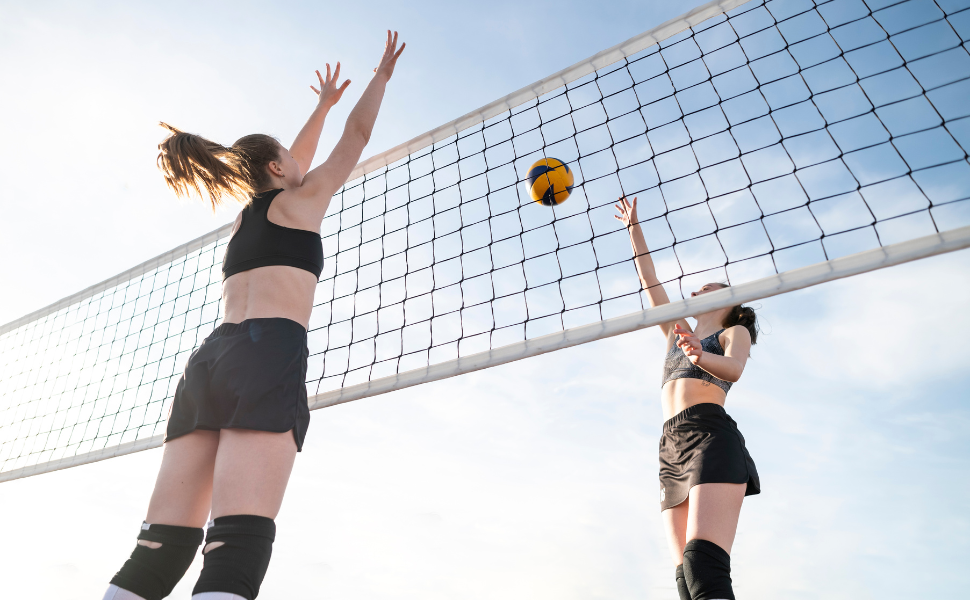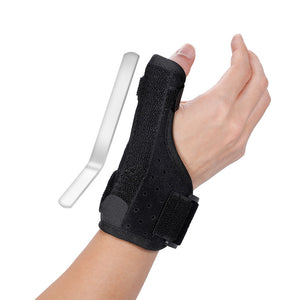How to Prevent Volleyball Injuries?

Do you want to know how to prevent volleyball injuries? Volleyball, a globally popular sport, which perfectly integrates athletic passion, the intelligence of strategy and teamwork, is enjoyed by billions of people who love it most intimately.
By its wide attraction, this sport is loved by people of all ages and levels. More and more people are joining it to enjoy a healthy life.
However, high-intensity exercise, in particular frequent jogging, leaping and rapid changes of direction, can easily lead to ankle sprains and knee injuries. Sudden sliding is even worse, making it very easy to strain the ligaments and tendons around the knee.
Apart from getting warmed up, training for strength and flexibility, volleyball players need to optimize the risk of shoulder and knee injuries by wearing the right protective equipment such as shoulder pads and knee pads.
This article will detail general volleyball injuries and preventative measures to be taken to help as you enjoy your sport safely.

Common Injuries in Volleyball Sports
Before we dive into how to prevent volleyball injuries, allow us to understand the common accumulation of injuries in the game:
1. Sprain
Ankles and knees are under tremendous stress in volleyball. Dynamic movements such as repeated running and skipping or sudden changes of direction can easily contribute to sprains of the joints that occur. Especially in ankles, ligaments are easily overstretched or torn when the athlete quickly turns direction or landed on the ground unsteadily, which causes severe pain, swelling and limits the range of motion of the joints.
2. Strain
Recurrent strenuous movements in volleyball, such as serving and dunking, use enormous strain on the shoulder and leg muscles and tendons. Especially the volleyball shoulder injuries is vulnerable to pulling due to the large swing of the arm when dunking the ball. Strain not only makes the match painful and uncomfortable, but also seriously affects the player's athletic performance a lot. Repetitive, high-intensity actions put the muscles and tendons responsible for the movement under chronic tightness, which in turn limits the risk of getting injured the most. Strains are one of the the most common volleyball injuries in volleyball, resulting in many difficulties for players in training and competition.
3. Impact injury
Impact injuries are a common type of injury in volleyball and usually occurred with collisions between players and players, the ball or the court. These types of injuries can be caused by ecchymosis, fractured bones, even concussions, and more. Difficult movement such as jump serves and blocks, as well as accidental collisions, are the main causes of impact injuries. In severe cases, deep tissue lesions can be caused as well.

How to Prevent Volleyball Injuries?
As a volleyball enthusiast, it's a good bet that you want to know how to prevent volleyball injuries and enjoy the sport you love! Here are some tips:
1. Basic Preventive Measures
An ample warm-up is necessary before volleyball practice in order to preclude sports damage. Dynamic stretching and movement can greatly optimize blood flow as well as strengthen the flexibility of the joints of the body as a whole.
The right technique for serving, snapping, two-passing and jumping is the key to preventing knee and shoulder injuries. All these techniques can effectively release stress on the joints and muscles of the body. Simultaneously eliminating overtraining and sufficient intervals of rest between training periods can be effective in inhibiting exhaustion and in lowering the perceived risk of knee and shoulder impairment from developing as a result of the training program.
Volleyball players can both improve their performance on the court and effectively guarantee their health through such preventive technique as these.
2. Physical Fitness Training
Physical fitness training is required for volleyball players by all means. By strengthening your shoulders, legs and core muscles, not only do you increase your strength, but you also boost your body balance, setting a firm foundation for you to do your best on the playing field.
The stretching exercise also improves agility and lowers the potential for pulling and spraining during dynamic movements.
Elevate your ability to be more flexible and mobile on the court with training in balance and alignment in your program.
3. Use Volleyball Protective Equipment
In addition to scientifically based training and exercise, there is also a key component to opting for the right protective equipment to forestall volleyball damage.
When diving or falling, putting on knee supports can offer strong protection for your knees and effectively forestall scuffs, bruises and other sports injuries.
People who play sports frequently or who have a history of ankle injuries can provide better support by carrying an ankle support instead with them. It is known to boost the stabilization of the ankle joint and lower the risk of getting injured at all.
It is a great choice to get a pair of expert volleyball shoes with outstanding ankle support and comfort in order to lower the risk of ankle sprains.
Different Types of Volleyball Protective Equipment
How do you choose the right sports protective equipment to protect your muscles and ligaments in volleyball? Below is a comprehensive guide to the gear you need to make the most of protecting your muscles and ligaments in volleyball. We will explore in depth the variety of protective equipment types, functions, and critical elements to take into consideration when shopping to aide you in making an informative choice to minimize the incidence of athletic injury risk.
1. Wrist Brace
Supplying solid support for the wrist joint, the wrist brace for volleyball can effectively prevent common sports injuries such as sprains and strains caused by repetitive movements such as passing and dunking, and boost sports safety.
In picking a volleyball wrist support, you should be prioritizing breathable, moisture wicking quality materials to keep your wrists dry and more comfortable. Wrist supports should also be appropriately fastened to provided support without interfering with wrist activities by the wrist.
The appropriate approach should be to lay the brace at the wrist by adjusting the fastening device to match the profile of the wrist to allow proper support without restricting wrist movement with the wrist.
2. Knee Brace
In volleyball, the knee is the most vulnerable part of the athlete. Frequent jumping, running and landing maneuvers can easily lead to patellar tendonitis, ACL tears and meniscus injuries.
However, volleyball is hard on the knee, with a good knee brace supporting the knee and reducing the risk of sports injuries. There is a wide range of knee pads available, from sleeves, straps and hinged braces to meet non-stop demand.
It is equally imperative that the comfortable fit of the best knee brace for volleyball is an important considerations at all. Pick an adjustable knee brace, a device designed to customize the fit through straps or buckles, to guarantee that the brace stays in position on the kneecap which may provide just the proper amount of both compression and support while eliminating the need to interfere with blood circulation.
3. Shoulder Brace
Repetitive over-the-shoulder maneuvers can easily leads to shoulder injuries, such as rotator cuff strains. With a view to lessening the incidence of injury hazards, choose a suitable shoulder brace which can effectively sustain and mobilize the rotator cuff joint as well.
Pick a comfortable and professional shoulder brace for your volleyball or over-the-top sports! Adjustable straps and soft pads are designed to make you more comfortable while working out, while effectively protecting your shoulders.
How do you put on a shoulder brace? Place the shoulder in the center of the brace, put on the arm and fasten the shoulder strap. The brace should support you adequately while allowing you to be comfortable by securing maximum freedom of mobility from your arm.

Where to Buy Volleyball Protective Gear?
Not only can wearing protective gear during volleyball prevent injuries, but it also allow us to better relish the sport. But where should you get your gear from?
Fivali is known for designing exceptional fitness and exercise products that support muscles, prevent injuries and make fitness easier for everyone. Our company provides a wide variety of sports supports and products to help you perform well and protect you from injuries.
At Fivali, we provide you with high quality volleyball pads at an affordable price. We have extensive and diverse range of volleyball wrist guards to provide all-around protection for your wrists. We also provide a wide range of knee braces to meet your different protection needs in different style.
Our volleyball shoulder supports are designed for high lifting movements, providing strong support and effectively lowering the risk of rotator cuff pulls and other common volleyball shoulder injuries, helping you to swing freely. Through scientific training methods and professional sports equipment, volleyball players can lower the risk of injuries, enjoy the fun of sports in order to raise the athletic performance effectively at all.
Sweat it out by choosing Fivali's top of the line protective gear! Whether training or competing, it builds a strong wall of protection so that you can concentrate on winning without fear of any kind of challenge.
Visit our website and learn more tips!













